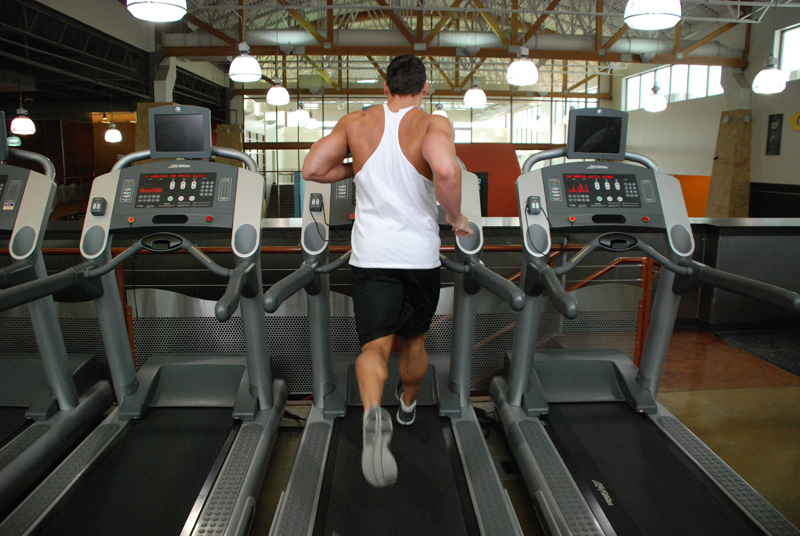Before I ever started training or doing cardio, I told myself, “the harder you work, the better the result.” Makes sense, right?
Well, then someone told me, “No, actually, when it comes to aerobic work, you’ll want to do longer duration, less intense exercise for the greatest fat burning.” It took awhile to buy that, but then I did – for years. So there I was, doing low intensity, hour long workouts on a treadmill, thinking I was burning adequate fat.
Truth was, I was dieting hard enough that the fallibility of that theory didn’t show itself.
But the other reason the theory about low intensity cardio came into being is that studies showed it burned a greater percentage of calories from fat, not carbs.
So years later, when someone else told me that high-intensity aerobic work would burn more fat than low intensity aerobic work, I had a hard time buying it.
“No, just try it,” he said.
So I did. And without dieting, without other efforts, I lost more body fat than I had ever imagined possible – and all from HIIT Cardio.
High Intensity Interval Training for Cardio is just that – a series of high intensity moves that work within intervals. That is to say, moderate cardio interspersed with high intensity work that works the heart rate between moderate and intense ranges.
The great thing about HIIT is its versatility – whether in the gym or out. I like running stairs or doing track sprints, but sometimes it’s just nice to get it all done in the confines of my gym. Driving to a track, with these gas prices, might be unnecessary. After all, you can sprint anywhere.
To gain maximum benefit from a HIIT program, you’ll need to perform HIIT exercises – two different types of cardio within two pace ranges that differ – at least four times a week. Off days are perfect for HIIT cardio days and I try my hardest to get most of them in on days I’m not training.
Studies show that HIIT burns up to 50 percent more fat. It also has been shown to burn more calories, by and large, than traditional cardio. But the greatest thing about it is that most of those calories and metabolic boost will occur after you’ve finished!
That’s because your body has gone into EPOC (excess post-exercise oxygen consumption). In English, that means, you have consumed a lot more oxygen recovering from the exercise session than you might have if you had just done a workout utilizing a steady pace.
The easiest way to work into HIIT, (and you will have to work into doing it), is by choosing one piece of stationary equipment in the gym – such as a stepper or elliptical trainer or cycle – and varying pace and resistance for short durations, back and forth.
So, in a first week, you’ll want to do 2 minutes of cardio at your normal pace, then bump it up for 1 to 2 minutes to a sprint, then back to normal and so on. You’ll want to do this for at least 15 to 20 minutes and just do what you can.
Seeing where you are is important, because it dictates how to proceed. If you suck wind at 1 minute of sprints, then stay there for a week or two and increase as you can – but try to push yourself.
Another good way is to jog for a minute or two and then sprint for a minute or two – going back and forth. With jogging though, you’ll want to do 30 second intervals of jog and sprint. And at the 10 minute mark, do a brisk walk instead of a jog or sprint, and resume, or quit, depending upon your fitness level. If it’s poor, 10 minutes of jog and sprint outside is about the equivalent of 20 minutes of the same on a stationary cycle. Fact is, it’s just harder outside moving your own full weight.
Some people recommend doing just 4 or 5 minutes total on your first day. Don’t kill yourself, but 4 or 5 minutes isn’t going to anoint you into the ways of HIIT. Every other workout, you’ll add a minute to your workout.
Here’s how a variety of HIIT workouts might look:
10 to 15 Minutes:
30 seconds jogging
30 seconds stair run
2 minutes moderate elliptical trainer pace
1 minute sprint pace on elliptical trainer
1 minute cycling
1 minute sprints
Some people like sticking with 30 second intervals throughout, and just increase the span of time within which they are working. So, for example, in their first week, they’ll do 10 to 15 minutes of 30 second intervals, but after the sixth week, they’ll be working within a 22 to 25 minute total range.
Whichever is most comfortable to you, but the point is you don’t want to exceed 2 minutes of high intensity work, since it is anaerobic. You want to get in and get out. I recommend doing 1 to 2 minutes of sprint or high intensity work on stationary equipment mainly because you aren’t fighting the gravity of your own body, so you must work harder.

